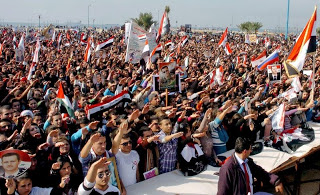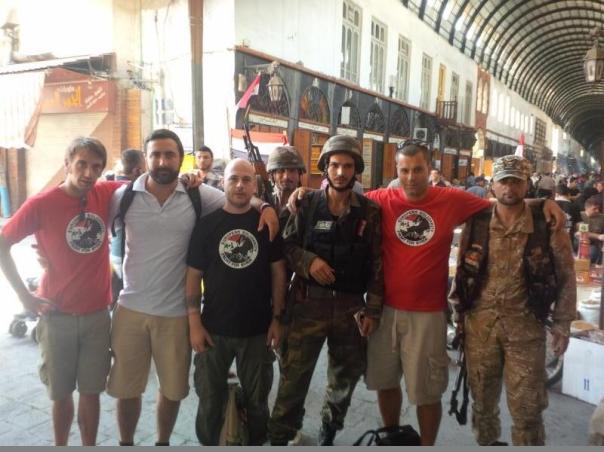DOCUMENTING EVIL: INSIDE ASSAD’S HOSPITALS OF HORRORWhen a photographer-archivist working for Syria’s military police defected with grisly evidence of the regime’s brutality, he became a war-crimes whistle-blower. Adam Ciralsky uncovers “Caesar’s” story....There are lots of Caesars,” said Dr. Abu Odeh, who worked at both Tishreen and a smaller facility called Harasta, on the outskirts of Damascus. I visited him this spring in a Turkish border town. (Abu Odeh is a pseudonym; the doctor, who aids Syrian refugees, still has family inside Syria.) “Caesar took pictures in the military hospitals. We lived there, 24/7.” Abu Odeh said that some patients were dead on arrival—brought to the facilities in official vehicles or even passenger cars—while others were tortured and killed following admission. “Each mark you see [on the bodies], cigarette marks and the like, was done in front of me. The Mukhabarat [intelligence officers] would be smoking when I’d walk into the room [for a consultation], and they’d put out their cigarettes on the patients and yell, ‘Get up, the doctor is here!’ ”
Caesar and his cohorts were responsible for providing a photographic record of death, but it fell to doctors such as Abu Odeh to pronounce a cause—which generally meant making one up. “Almost every day the Mukhabarat would drive up and bring dead bodies with them,” he explained. “I’d go out to the car, find a corpse lying in the back seat, can you imagine? Even if the dead guy was missing his head, the Mukhabarat demanded that I write that he died of ‘sudden death.’ That was their preferred choice, even though the injuries I saw ranged from, well, decapitation to electric shocks to stab wounds to ligature marks around the neck. This much was clear: these people had not died of natural causes. They were tortured to death by the intelligence services.” Abu Odeh said he would generate about seven to eight death reports a day.
With introductions furnished by the Syrian opposition and humanitarian-aid workers, I interviewed six other medical professionals who had firsthand knowledge of what Syria’s military hospitals have become. “Every day I saw 30 to 40 dead bodies,” a nurse named Ayman al-Abdallah told me. He claimed to have worked for 12 years at Tishreen before leaving Syria; as proof, he provided pictures and his military I.D. “I also witnessed cases where people were tortured. I will never forget people who had acid on their hips. I could see straight through to the bone.”
Al-Abdallah, a Sunni, is unique in that he had access to a high-security underground area at Tishreen, an alternative emergency room, that was otherwise off-limits to non-Alawites. “The alternate E.R. had four rows of beds with two people in each bed,” al-Abdallah recalled. “They were chained to each other and to the bed, and they were blindfolded. Every night the soldiers would get up on the beds and start walking on the patients. It was a ritual.” Another ritual, he said, was wrapping men’s genitals so tightly with a rubber glove that the pressure would cut off circulation. According to Abu Odeh, intelligence agents would walk up to patients recovering from surgery to repair bone fractures and would literally rip external fixations—used to hold bones in place—from their broken limbs. “So many times we had to do operations twice,” he said. “They weren’t doing this torture to get patients to talk—it was just torture. Sometimes the Mukhabarat guys would pee on the wounds. Other times they would dip a prisoner’s bandages in toilet water and put them back on.”
Some of those brought into the hospital with bone fractures, it turned out, had been medical aides wounded in Syrian air strikes and shellings. According to ward staffers, the security forces doing the torture seemed to be singling out their victims because their presence on the battlefield—as evidenced by their wounds—suggested that they had been pitching in to help treat the enemy: injured anti-government troops. Indeed, the Assad administration, according to recent reports by both the U.N. and Physicians for Human Rights, has appeared to deliberately target medical transport, clinics, and their staff.
The facilities had another purpose as well. To hear Abu Odeh and al-Abdallah tell it, Tishreen—while a torture chamber for perceived regime opponents—remained a functioning hospital for loyalists and served as something of a showcase for visiting dignitaries and foreign soldiers, who would walk through the wards and speak with injured government troops. “I saw Iranians and Hezbollah fighters come through,” al-Abdallah told me. “The Russians and North Koreans would also show up.” Abu Odeh spoke about the time his bosses requested that he put in an appearance the day Bashar al-Assad himself was scheduled to do a walk-through, in 2011. “In the days leading up to his visit, they took the healthiest people and put them in place. The Army gave people talking points, telling doctors, patients, and their families what to say and not to say.”
By his own account, Abu Odeh, like a number of Sunnis within the military-hospital system, was pulling double duty: treating regime members in the daytime and then moonlighting at field clinics, where he would patch up opposition combatants and their civilian supporters. He worked at Tishreen on the morning of the Assad visit, but persuaded his superiors to cancel his televised cameo, arguing that appearing alongside the president might increase the risk that rebels would recognize him, accuse him of being a government lackey, and kill him at a checkpoint. (Three weeks after I met with him, he informed me that one of his close family members had been arrested in Damascus, taken to an interrogation center, and sent to Harasta military hospital, where, two weeks later, that person died.)
In Turkey I also interviewed Eyad Ibrahim, a heavy-set man who worked as a nurse at Tishreen before the civil war and at the military hospital in Deir Ezzour after it began. “The killing is systematic,” insisted Ibrahim. He described a singularly abhorrent incident. In the aftermath of a raid that the Syrian Army conducted on Mou Hassan–Ibrahim’s home village—a lieutenant in the Makhabarat, he recalled, began asking if any members of the medical team had grown up in that town. Confident that the officer already knew the staff members’ backgrounds, Ibrahim stepped forward. A short time later, he said, he was escorted to an area near the E.R. where he came face-to-face with a villager wounded in the raid. It was his cousin. “They ordered me to torture my cousin,” he conceded. “I did everything they asked. I beat him with my hands, kicked him with my legs, beating him and saying, ‘I’m sorry.’ ” After a pause, he added, “I wished the earth would have opened up and swallowed me whole. . . . No matter how we describe or explain the torturing and killing that took place in the military hospitals, we can’t do it justice.”
...I met a man in Istanbul whom I’ll call Youssef. He recounted to me his grueling experiences as a patient lost in the Syrian hospital system. He is a burly figure who still bears the scars of his odyssey through three interrogation sites and the wards at Mezzeh. In May 2013, while a prisoner (of Air Force Intelligence), Youssef became very ill and was taken to Hospital 601 (Mezzeh).
“I saw dead bodies in the rooms that were set aside for the different intelligence divisions,” Youssef began. He said space was at a premium and hygiene was not a priority. “Six people on each hospital bed, chained together at the foot. If a prisoner died in one of the beds, they would take the chain off the leg, put the corpse in the bathroom or in the hallway, and we’d have to step over it. . . . They’d stay there for a day or day and a half. Some prisoners were forced to take the bodies to an auto garage at Mezzeh.”
That garage—located not far from Assad’s palace—is a recurring backdrop in many of the pictures that Caesar spirited out. After Mezzeh ran out of space to store the deceased, Caesar would contend, the Syrians transformed an adjoining parking area into a makeshift morgue with a concrete roof and open sides. The photos depict rows of bodies—some naked, some wrapped in plastic—overseen by hospital attendants wearing masks, presumably to cope with the stench.
The situation often veered toward the surreal. According to a Syrian government intelligence report I obtained, a strange disagreement broke out at one point when a doctor at Harasta military hospital lodged a formal complaint. in which she argued that the Mukhabarat—not medical staffers—ought to be the ones placing detainees’ bodies in bags before burial. She also claimed that, at times, intelligence personnel would take the keys to the morgue freezer home with them at night. The Mukhabarat, in response, accused the doctor, on one occasion, of refusing to allow its officers entry when they tried to drop off corpses.
Meanwhile, Youssef told me that at Mezzeh “death was routine” and often came at the hands of the staff. Patients referred to one employee as “Abu Shakoush,” Arabic for “father of the hammer,” based on his facility with blunt instruments. “Another [worker] was Azrael, the archangel of death”—evoking the nickname associated with Dr. Josef Mengele, the SS physician who conducted sadistic experiments on inmates at Auschwitz. Youssef described how, one night, he and his fellow prisoners smelled what they thought was burning plastic. The next day, when they asked a staff member about the odor, Youssef said, “We were told Azrael melted a plastic bucket over someone’s head until [he] burned to death.”
Ahmad al-Rez, a Syrian émigré now living in Western Europe, spoke to me about Tishreen hospital. In February 2012, he claimed, he was at the Damascus International Airport when he was pulled aside by members of Branch 215. “They said, ‘Come with us for two minutes.’ Two minutes turned into two years.” After falling ill at Syria’s infamous Sednaya prison, he was taken to Tishreen. On his initial stay, in October 2013, al-Rez said, he was regularly denied food and water, and the guards would routinely beat him with what patients mockingly referred to as the “Lakhdar Brahimi,” a green stick named after the former U.N. and Arab League’s joint special representative to Syria (who, in 2012, had been dispatched to persuade Assad to step down or accept a transitional process toward that end). Two months later, al-Rez said he was re-admitted to Tishreen and over the course of two days was ordered to use plastic to wrap 20 or more corpses, whose prisoner numbers had already been inscribed on their foreheads. “Tishreen,” he concluded, “is a killing center.”






